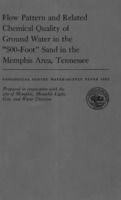The '500-foot' sand is the major source of water supply for the Memphis area. Thick layers of impervious clay above and below the sand confine the water in the aquifer under artesian pressure and also protect the aquifer from contamination. Recharge from rainfall enters the '500-foot' sand in the outcrop, or intake area south and east of Memphis. Recharge from other aquifers enters the sand wherever the confining beds are breached or absent. Some of the recharge that enters the '500-foot' sand in eastern Arkansas moves down the gradients created by pumping in the Memphis area. All discharge from the '500-foot' sand in the Memphis area results from well pumping.
Since 1886 continuous withdrawals at gradually increasing rates of pumping have lowered water levels and altered hydraulic gradients in the area. These withdrawals have resulted in changes in direction and velocity of movement of water through the '500-foot' sand. Water in the sand in the southeaster n part of the Memphis area normally moves from the (outcrop area east and south of Memphis northwestward toward points of withdrawal. In the northwestern part of the area, water moves southeastward toward points of withdrawal. A flow-net analysis of the aquifer shows that the rate of water movement through the '500-foot' sand in 1964, toward the major cones of depression in the Memphis area, was about 350 feet per year, or 1 mile in 15 years. A flow-net analysis projected for the year 1975 indicates the rate will increase by about 20 percent in the 12-year period 1964-75.
Water in the '500-foot' sand in the Memphis area is generally a calcium magnesium sodium bicarbonate type. It is soft, low in dissolved solids, high in concentrations of iron and carbon dioxide, and slightly to moderately corrosive. The softest and least mineralized water occurs in the southeastern part of the area, and the water becomes slightly harder and more mineralized as it moves downdip toward Memphis. The hardest and most mineralized water occurs in the northwestern part of the area.
The variations in chemical quality of water en route through the '500-foot' sand are virtually proportional to increases or decreases of the major chemical constituents. The variations are chiefly attributed to the mixing or blending of water from different directions or sources of recharge as wells are pumped. As water levels are lowered by continuous pumping in the future, increasing rates of recharge from the outcrop areas and from shallow aquifers will probably cause little, if any, change in chemical quality of the water. Certainly, the effects on quality are not expected to be detrimental.
Although future changes in chemical quality of water in the '500-foot' sand in the Memphis area will probably be neither intense nor extensive, some changes can be anticipated as a result of man's activities associated with the continued growth and development of the area. Increased pumping at existing pumping centers will deepen existing cones of depression and thereby increase gradients. These increases will not necessarily cause a change in chemical quality unless the increases in pumping are unevenly distributed. If a major well field were developed in the '500-foot' sand in the southwestern part of the Memphis area, little change in quality would result because water would be caused to move toward the well field from both the northwest and southeast. This movement would not affect the blending of updip and downdip water at other well fields If water were impounded in the Wolf River a few miles upstream from Memphis, the impoundment could furnish recharge, at least temporarily, to the '500-foot' sand. It is improbable that any detrimental effects on the chemical quality of the water supply of Memphis would result, because the water in the impoundment would probably be softer ,and less mineralized than the water in the '500-foot' sand in that area.


